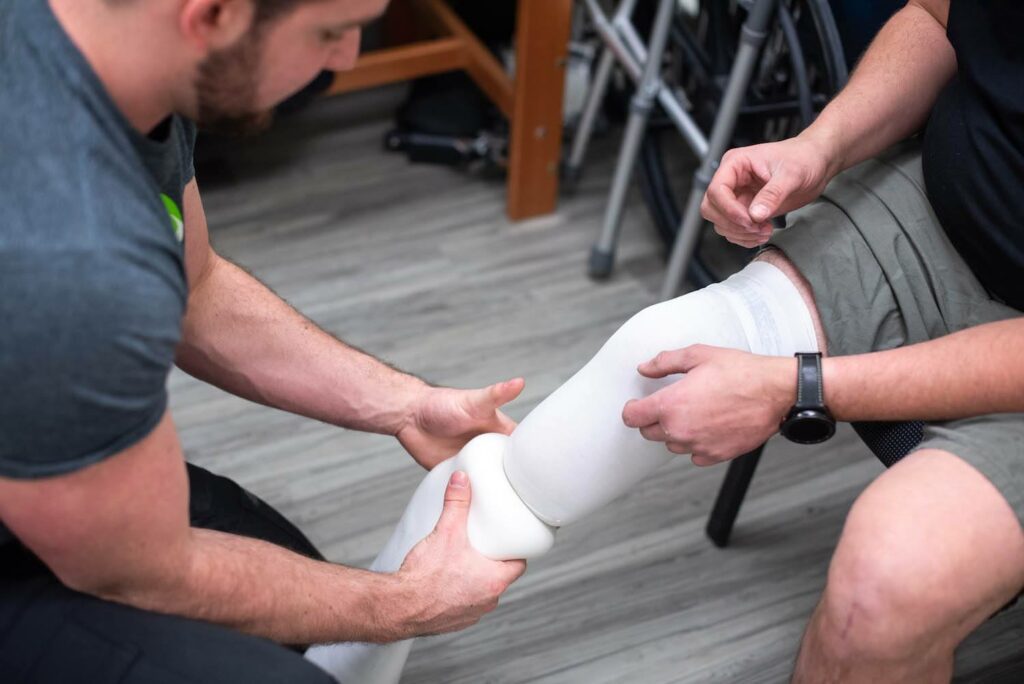
Common Questions about Prosthetics
As a pre-operative amputee patient or recent amputee, there are many questions about what comes next. Recent amputees often have many questions about prosthetics. Today, we wanted to address some of the more common questions about prosthetics and provide some insight on the road ahead for lower limb amputees. One of the first topics that come up for recent amputees is if they would benefit from receiving lower limb prosthesis.
Should I get a prosthetic leg?
Many factors go into whether a lower limb prosthesis is suitable for an amputee. Examples include the volume of soft tissue available to cushion bone, localized pain, condition of the skin on the limb, and the residual limb’s range of motion. Common determining questions include, how healthy is your other leg, and what was your activity level like prior to amputation? What are your mobility goals? Another consideration is the amputation site. A below-the-knee prosthesis allows for better mobility and reduced effort to move than an above-the-knee prosthesis. A more sedentary individual with amputation caused by chronic health issues can have more difficulty adapting to a prosthetic leg than a highly active individual who lost their limb to accident or injury.
How does a prosthetic leg work?
A prosthesis is a tool that acts as an extension of your natural body to provide you enhanced mobility. A prosthetic limb is custom-made specifically for an amputee based on their size, ability, needs, and goals. Prosthetists create artificial limbs using different specs to create a prosthesis that is right for the amputee’s lifestyle. The amputee’s residual leg will be covered with a liner and one or more socks to create a comfortable and clean barrier between the limb’s socket and the limb. The socket is then attached to the liner by a locking pin, suspension sleeve, or other mechanism to keep the limb connected while suspended. The prosthesis will feature a foot joint and potentially a knee joint to assist the amputee with a more natural walking gait and articulation while seated.
The cosmetics of your prosthesis are up to you. Some amputees like the practical, utilitarian look of the bare components. Other amputees prefer the cosmetic look of a natural-looking limb. Some amputees go full out using their limb as a canvas to display tattoo-style illustrations, their favorite sports team, or other bold designs that reflect their personality. Because the prosthesis is an extension of yourself, it’s important to take some time considering what you want your prosthetic to look like.
How long can I wear my prosthetic leg?
For amputees adjusting to a new prosthesis, the recommended maximum is two hours of wear with 30 minutes of walking or standing. The walking/standing does not need to be completed all at once. If you meet the maximum time and your leg feels good, continue increasing daily wear by one hour with an additional 15 minutes of walking/standing each additional day. Even if your leg feels good once reaching the maximum wear time, you should remove the prosthesis and allow your body to rest before increasing time the next day.
Can I wear my prosthesis in the shower?
The recommendation is that you remove your prosthesis when bathing. First, many prosthetic leg components are sensitive to moisture, and water exposure can affect your prosthesis’s ability to function correctly. The second reason is that it’s vital to thoroughly clean your residual limb stump to ensure it stays healthy, requiring removing all prosthesis components, including prosthesis, socket, socks, liners, and shrinkers. For amputees interested in swimming or other water-based activities, there are specialty prosthetic limbs and airtight covers available for amputees to enjoy swimming and other watersports.
How soon can I return to before amputation level activity?
An amputee’s recovery depends heavily on your health, drive, and goals. For many, the first year is challenging. In addition to the physical recovery of surgery, the shape and size of your residual limb will fluctuate, and your body will need exercise and time to recondition your muscles. You will also need to relearn basic mobility activities like gait, balance, and coordination—all of which require you to learn to trust your prosthesis.
We strongly recommend new amputees and prosthesis wearers find a local support group. The support of a community of people who understand specifically what you are going through because they are also going through it is extremely helpful. Much of your success is dependent on emotional resilience and staying motivated through difficult times. Being able to share that difficulty with peers makes a big difference.
How long will my prosthesis last?
This is one of the most common questions about prosthetics. The answer is, it depends on wear and tear and your activity level. An active person whose weight and mass fluctuate more often will need more resizing, refitting, and replacements than a more sedentary lifestyle with little weight and mass fluctuation. You can expect a new socket may need to be fitted with your prosthesis in the first year as your residual limb tissue settles into its permanent shape. In general, temporary prosthesis last a few months, and permanent prosthesis last 3-5 years, depending on wear. If you experience new pain, discomfort, or a lack of stability with your prosthetic leg, it’s time to check with your prosthetist for an evaluation.
Taking the Next Step
These answers only scratch the surface of questions amputees have when considering a prosthesis. You can find some resources on our website to help you research prosthetics and help you decide if a prosthesis is right for you.
We urge you to contact us directly if you have questions about Texas Orthotic & Prosthetic Services, or how a prosthetic limb can help to improve your life.


